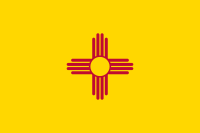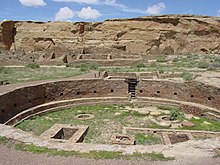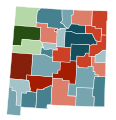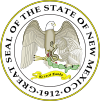Portal:New Mexico
The New Mexico Portal New Mexico (Spanish: Nuevo México [ˈnweβo ˈmexiko] ⓘ; Navajo: Yootó Hahoodzo Navajo pronunciation: [jòːtʰó hɑ̀hòːtsò]) is a landlocked state in the Southwestern region of the United States. It is one of the Mountain States of the southern Rocky Mountains, sharing the Four Corners region with Utah, Colorado, and Arizona. It also borders Texas to the east and southeast, Oklahoma to the northeast, and the Mexican states of Chihuahua and Sonora to the south. New Mexico's largest city is Albuquerque, and its state capital is Santa Fe, the oldest state capital in the U.S., founded in 1610 as the government seat of Nuevo México in New Spain. New Mexico is the fifth largest of the fifty states by area, but with just over 2.1 million residents, ranks 36th in population and 46th in population density. Its climate and geography are highly varied, ranging from forested mountains to sparse deserts; the northern and eastern regions exhibit a colder alpine climate, while the west and south are warmer and more arid. The Rio Grande and its fertile valley runs from north-to-south, creating a riparian climate through the center of the state that supports a bosque habitat and distinct Albuquerque Basin climate. One–third of New Mexico's land is federally owned, and the state hosts many protected wilderness areas and national monuments, including three UNESCO World Heritage Sites, the most of any U.S. state. New Mexico's economy is highly diversified, including cattle ranching, agriculture, lumber, scientific and technological research, tourism, and the arts; major sectors include mining, oil and gas, aerospace, media, and film. Its total gross domestic product (GDP) in 2020 was $95.73 billion, with a GDP per capita of roughly $46,300. State tax policy is characterized by low to moderate taxation of resident personal income by national standards, with tax credits, exemptions, and special considerations for military personnel and favorable industries. New Mexico has a significant U.S. military presence, including White Sands Missile Range, and strategically valuable federal research centers, such as the Sandia and Los Alamos National Laboratories. The state hosted several key facilities of the Manhattan Project, which developed the world's first atomic bomb, and was the site of the first nuclear test, Trinity. (Full article...) Entries here consist of Good and Featured articles, which meet a core set of high editorial standards.
Chaco Culture National Historical Park is a United States National Historical Park in the American Southwest hosting a concentration of pueblos. The park is located in northwestern New Mexico, between Albuquerque and Farmington, in a remote canyon cut by the Chaco Wash. Containing the most sweeping collection of ancient ruins north of Mexico, the park preserves one of the most important pre-Columbian cultural and historical areas in the United States. Between AD 900 and 1150, Chaco Canyon was a major center of culture for the Ancestral Puebloans. Chacoans quarried sandstone blocks and hauled timber from great distances, assembling fifteen major complexes that remained the largest buildings ever built in North America until the 19th century. Evidence of archaeoastronomy at Chaco has been proposed, with the "Sun Dagger" petroglyph at Fajada Butte a popular example. Many Chacoan buildings may have been aligned to capture the solar and lunar cycles, requiring generations of astronomical observations and centuries of skillfully coordinated construction. Climate change is thought to have led to the emigration of Chacoans and the eventual abandonment of the canyon, beginning with a fifty-year drought commencing in 1130. (Full article...)Selected article -Gerónimo (Mescalero-Chiricahua: Goyaałé, Athapascan pronunciation: [kòjàːɬɛ́], lit. 'the one who yawns'; June 16, 1829 – February 17, 1909) was a military leader and medicine man from the Bedonkohe band of the Ndendahe Apache people. From 1850 to 1886, Geronimo joined with members of three other Central Apache bands – the Tchihende, the Tsokanende (called Chiricahua by Americans) and the Nednhi – to carry out numerous raids, as well as fight against Mexican and U.S. military campaigns in the northern Mexico states of Chihuahua and Sonora and in the southwestern American territories of New Mexico and Arizona. Geronimo's raids and related combat actions were a part of the prolonged period of the Apache–United States conflict, which started with the Americans continuing to take land, including Apache lands, following the end of the war with Mexico in 1848. Reservation life was confining to the free-moving Apache people, and they resented restrictions on their customary way of life. Geronimo led breakouts from the reservations in attempts to return his people to their previous nomadic lifestyle. During Geronimo's final period of conflict from 1876 to 1886, he surrendered three times and eventually accepted life on the Apache reservations. While well-known, Geronimo was not a chief of the Bedonkohe band of the Central Apache but a shaman, as was Nokay-doklini among the Western Apache. However, since he was a superb leader in raiding and warfare, he frequently led large numbers of 30 to 50 Apache men. (Full article...)General images -The following are images from various New Mexico-related articles on Wikipedia.
Did you know -
TopicsLargest citiesCategoriesNew articlesThis list was generated from these rules. Questions and feedback are always welcome! The search is being run daily with the most recent ~14 days of results. Note: Some articles may not be relevant to this project.
Rules | Match log | Results page (for watching) | Last updated: 2024-05-07 21:26 (UTC) Note: The list display can now be customized by each user. See List display personalization for details.
Related portalsWikiProjectsAssociated WikimediaThe following Wikimedia Foundation sister projects provide more on this subject:
Sources |

































































